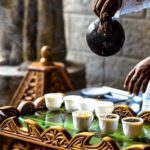My favorite Ethiopian coffee ceremony is under the veranda at Aster Abdella’s home. The mother of my good friend Sammy Abdella, founder of Sammy Handmade in Ethiopia ,there is no better coffee or hospitality then Asters home. Its not just the coffee, although it is divine, or the ceremony which is deliberate, full of careful attention to every detail. It is the sharing, the being part of a well loved custom that is quintessential Ethiopia. This part if the ceremony can only be experienced personally, but let me explain what is like. The Ethiopian coffee ceremony involves processing the raw, unwashed coffee beans into finished cups of coffee.
It begins with the preparation of the room for the ritual. First, the woman who is performing the ceremony spreads fresh, aromatic grasses and flowers across the floor. She begins burning incense to ward off evil spirits and continues to burn incense throughout the ceremony. She fills a round-bottomed, black clay coffeepot (known as a jebena) with water and places it over hot coals. Then, the hostess takes a handful of green coffee beans and carefully cleans them in a heated, long-handled, wok-like pan. Holding the pan over hot coals or a small fire, she stirs and shakes the husks and debris out of the beans until they are clean.
Once the beans are clean, she slowly roasts them in the pan she used to clean them. During the roasting, she keeps the roast as even as possible by shaking the beans (much like one would shake an old-fashioned popcorn popper) or stirring them constantly. The roasting may be stopped once the beans are a medium brown, or it may be continued until they are blackened and shimmering with essential oils. The aroma of the roasted coffee is powerful and is considered to be an important aspect of the ceremony. Its customary for the hostess to share the roasted beans with the guest to waft in the smell of the beans. In return, the guests share a nodding gesture of approval, waving their hands to take in the smoke and aroma of the roasted beans.
After the hostess has roasted the beans, she will grind them. She uses a tool similar to a
mortar and pestle. The “mortar” is a small, heavy wooden bowl called a
mukecha (pronounced moo-key-cha), and the “pestle” is a wooden or metal cylinder with a blunt end, called a
zenezena. With these tools, she crushes the beans into a coarse ground. By the time the beans are ground, the water in the
jebena is typically ready for the coffee. The performer removes a straw lid from the coffeepot and adds the just-ground coffee. The mixture is brought to a boil and removed from heat. The coffee is ready to be served.
A tray of very small, handle-less ceramic or glass cups is arranged with the cups very close together. The ceremony performer pours the coffee in a single stream from about a foot above the cups, ideally filling each cup equally without breaking the stream of coffee. The dregs of the coffee remain in the pot. This technique prevents coarse grounds from ending up in the coffee cups.
Guests may add their sugar if they’d like. Milk is not typically offered. After adding sugar, guests bunna tetu (“drink coffee”), and then praise the hostess for her coffee-making skills and the coffee for its taste. Each cup is said to transform the spirit, and be a blessing to those who drink it. And it is a blessing. It is always a new experience every time. I love it so. Thank you Aster. I look forward to next time.
-

-
Aster and Sammy the Garden
-

-
Beginning
-

-
Smoking the Beans
-

-
Serving the Guests
-

-
Bunna…ohhhh






